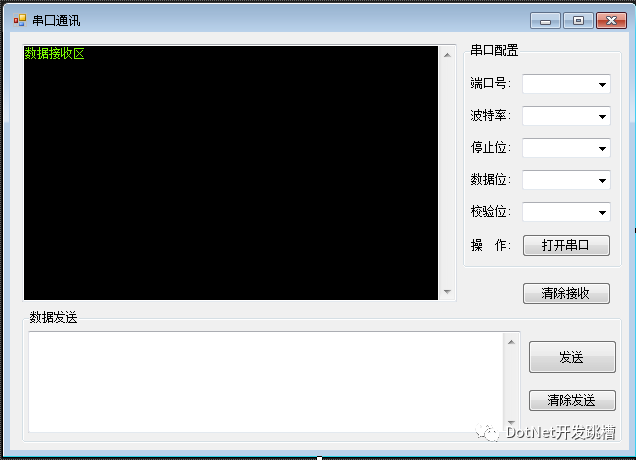一、串口通信简介
串行接口(串口)是一种可以将接受来自CPU的并行数据字符转换为连续的串行数据流发送出去,同时可将接受的串行数据流转换为并行的数据字符供给CPU的器件。一般完成这种功能的电路,我们称为串行接口电路。
串口通信(Serial Communications)的概念非常简单,串口按位(bit)发送和接收字节。尽管比按字节(byte)的并行通信慢,但是串口可以在使用一根线发送数据的同时用另一根线接收数据。串口通信最重要的参数是波特率、数据位、停止位和奇偶校验。对于两个进行通信的端口,这些参数必须匹配。
1. 波特率:这是一个衡量符号传输速率的参数。指的是信号被调制以后在单位时间内的变化,即单位时间内载波参数变化的次数,如每秒钟传送960个字符,而每个字符格式包含10位(1个起始位,1个停止位,8个数据位),这时的波特率为960Bd,比特率为10位*960个/秒=9600bps。
2. 数据位:这是衡量通信中实际数据位的参数。当计算机发送一个信息包,实际的数据往往不会是8位的,标准的值是6、7和8位。标准的ASCII码是0~127(7位),扩展的ASCII码是0~255(8位)。
3. 停止位:用于表示单个包的最后几位。典型的值为1,1.5和2位。由于数据是在传输线上定时的,并且每一个设备有其自己的时钟,很可能在通信中两台设备间出现了小小的不同步。因此停止位不仅仅是表示传输的结束,并且提供计算机校正时钟同步的机会。
4. 校验位:在串口通信中一种简单的检错方式。有四种检错方式:偶、奇、高和低。当然没有校验位也是可以的。
二、C#串口编程类
从.NET Framework 2.0开始,C#提供了SerialPort类用于实现串口控制。命名空间:System.IO.Ports。其中详细成员介绍参看MSDN文档。下面介绍其常用的字段、方法和事件。
1. 常用字段:
| 名称 | 说明 |
| PortName | 获取或设置通信端口 |
| BaudRate | 获取或设置串行波特率 |
| DataBits | 获取或设置每个字节的标准数据位长度 |
| Parity | 获取或设置奇偶校验检查协议 |
| StopBits | 获取或设置每个字节的标准停止位数 |
2. 常用方法:
| 名称 | 说明 |
| Close | 关闭端口连接,将 IsOpen 属性设置为 false,并释放内部 Stream 对象 |
| GetPortNames | 获取当前计算机的串行端口名称数组 |
| Open | 打开一个新的串行端口连接 |
| Read | 从 SerialPort 输入缓冲区中读取 |
| Write | 将数据写入串行端口输出缓冲区 |
3. 常用事件:
| 名称 | 说明 |
| DataReceived | 表示将处理 SerialPort 对象的数据接收事件的方法 |
三、C#开发串口实例
前台页面:

后台代码:
using System;
using System.IO.Ports;
using System.Text;
using System.Windows.Forms;
namespace SerialPort
{
public partial class SerialPort : Form
{
String serialPortName;
public SerialPort()
{
InitializeComponent();
}
private void Form1_Load(object sender, EventArgs e)
{
string[] ports = System.IO.Ports.SerialPort.GetPortNames();//获取电脑上可用串口号
comboBox1.Items.AddRange(ports);//给comboBox1添加数据
comboBox1.SelectedIndex = comboBox1.Items.Count > 0 ? 0 : -1;//如果里面有数据,显示第0个
comboBox2.Text = "115200";/*默认波特率:115200*/
comboBox3.Text = "1";/*默认停止位:1*/
comboBox4.Text = "8";/*默认数据位:8*/
comboBox5.Text = "无";/*默认奇偶校验位:无*/
}
private void button1_Click(object sender, EventArgs e)
{
if (button1.Text == "打开串口"){//如果按钮显示的是打开
try{//防止意外错误
serialPort1.PortName = comboBox1.Text;//获取comboBox1要打开的串口号
serialPortName = comboBox1.Text;
serialPort1.BaudRate = int.Parse(comboBox2.Text);//获取comboBox2选择的波特率
serialPort1.DataBits = int.Parse(comboBox4.Text);//设置数据位
/*设置停止位*/
if (comboBox3.Text == "1") { serialPort1.StopBits = StopBits.One; }
else if (comboBox3.Text == "1.5") { serialPort1.StopBits = StopBits.OnePointFive; }
else if (comboBox3.Text == "2") { serialPort1.StopBits = StopBits.Two; }
/*设置奇偶校验*/
if (comboBox5.Text == "无") { serialPort1.Parity = Parity.None; }
else if (comboBox5.Text == "奇校验") { serialPort1.Parity = Parity.Odd; }
else if (comboBox5.Text == "偶校验") { serialPort1.Parity = Parity.Even; }
serialPort1.Open();//打开串口
button1.Text = "关闭串口";//按钮显示关闭串口
}
catch (Exception err)
{
MessageBox.Show("打开失败"+ err.ToString(), "提示!");//对话框显示打开失败
}
}
else{//要关闭串口
try{//防止意外错误
serialPort1.Close();//关闭串口
}
catch (Exception){}
button1.Text = "打开串口";//按钮显示打开
}
}
protected override void WndProc(ref Message m)
{
if (m.Msg == 0x0219){//设备改变
if (m.WParam.ToInt32() == 0x8004){//usb串口拔出
string[] ports = System.IO.Ports.SerialPort.GetPortNames();//重新获取串口
comboBox1.Items.Clear();//清除comboBox里面的数据
comboBox1.Items.AddRange(ports);//给comboBox1添加数据
if (button1.Text == "关闭串口"){//用户打开过串口
if (!serialPort1.IsOpen){//用户打开的串口被关闭:说明热插拔是用户打开的串口
button1.Text = "打开串口";
serialPort1.Dispose();//释放掉原先的串口资源
comboBox1.SelectedIndex = comboBox1.Items.Count > 0 ? 0 : -1;//显示获取的第一个串口号
}
else{
comboBox1.Text = serialPortName;//显示用户打开的那个串口号
}
}
else{//用户没有打开过串口
comboBox1.SelectedIndex = comboBox1.Items.Count > 0 ? 0 : -1;//显示获取的第一个串口号
}
}
else if (m.WParam.ToInt32() == 0x8000){//usb串口连接上
string[] ports = System.IO.Ports.SerialPort.GetPortNames();//重新获取串口
comboBox1.Items.Clear();
comboBox1.Items.AddRange(ports);
if (button1.Text == "关闭串口"){//用户打开过一个串口
comboBox1.Text = serialPortName;//显示用户打开的那个串口号
}
else{
comboBox1.SelectedIndex = comboBox1.Items.Count > 0 ? 0 : -1;//显示获取的第一个串口号
}
}
}
base.WndProc(ref m);
}
private void serialPort1_DataReceived(object sender, SerialDataReceivedEventArgs e)
{
int len = serialPort1.BytesToRead;//获取可以读取的字节数
byte[] buff = new byte[len];//创建缓存数据数组
serialPort1.Read(buff, 0, len);//把数据读取到buff数组
Invoke((new Action(() =>{//C# 3.0以后代替委托的新方法
textBox1.AppendText(Encoding.Default.GetString(buff));//对话框追加显示数据
})));
}
private void button2_Click(object sender, EventArgs e)
{
textBox1.Clear();//清除接收对话框显示的数据
}
private void button3_Click(object sender, EventArgs e)
{
String Str = textBox2.Text.ToString();//获取发送文本框里面的数据
try
{
if (Str.Length > 0)
{
serialPort1.Write(Str);//串口发送数据
}
}
catch (Exception){ }
}
private void button4_Click(object sender, EventArgs e)
{
textBox2.Clear();//清除发送文本框里面的内容
}
}
}
)





 - Resource及关键字 的使用)
)



)


)


、压缩、加密、解密、混淆工具-toolfk程序员工具网)

![[ci]jenkins server启动,通过jnlp的方式启动slave(容器模式)](http://pic.xiahunao.cn/[ci]jenkins server启动,通过jnlp的方式启动slave(容器模式))